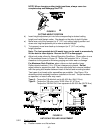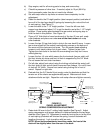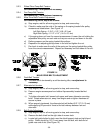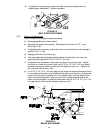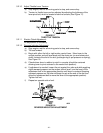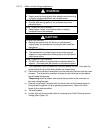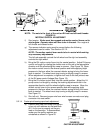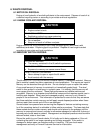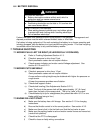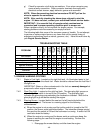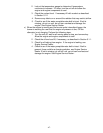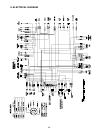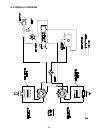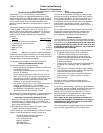
- 45 -
6.4 BATTERY DISPOSAL
DANGER
POTENTIAL HAZARD
♦ Battery electrolyte contains sulfuric acid, which is
poisonous and can cause severe burns
WHAT CAN HAPPEN
♦ Swallowing electrolyte can be fatal or if it touches skin
can cause severe burns.
HOW TO AVOID THE HAZARD
♦ Wear safety glasses to shield eyes, and rubber gloves
to protect skin and clothing when handling electrolyte.
♦ Do not swallow electrolyte.
Federal law states that batteries should not be placed in the garbage. Management and
disposal practices must be within relevant federal, state, or local laws.
If a battery is being replaced or if the unit containing the battery is no longer operating and
is being scrapped, take the battery to a local certified recycling center. If no local recycling
is available return the battery to any certified battery reseller.
7. TROUBLE SHOOTING
7.1 MOWER PULLS LEFT OR RIGHT (W/LEVERS FULLY FORWARD).
a) Refer to Tracking Adjustment Section 4.1.3.
b) Check air pressure in drive tires;10 psi.
Semi-pneumatic casters do not require inflation.
c) Check reverse indicator and motion control linkage adjustment. See
section 5.2.12 and 5.2.13.
7.2 MOWER CUTS UNEVENLY.
a) Check air pressure in drive tires; 10 psi.
Semi-pneumatic casters do not require inflation.
A more uniform cutting height may be obtained with higher tire pressure on
rough terrain.
A lower tire pressure provides more flotation.
b) Check deck support chains.
c) Check deck leveling (See Adjustments Section 5.2.2.)
Note: The front of the mower deck will be approximately 1/4” (6.4 mm)
lower than the back of the mower deck. This is the “rake” of the deck.
d) Check blades tip to tip for straightness (they should be within 3/16" or one
blade width from being in line.)
7.3 ENGINE WILL NOT START.
a) Make sure the battery has a full charge. See section 5.1.3 for charging
instructions.
b) Be sure the throttle control is in the correct position. See section 4.3.3.
c) Make sure there is fuel in the fuel tank and that the fuel valve is open.
d) Make sure the parking brake is set and motion control levers are moved out
(neutral lock position).
e) Check that the PTO is disengaged.
f) Check for loose or faulty wiring connections.



